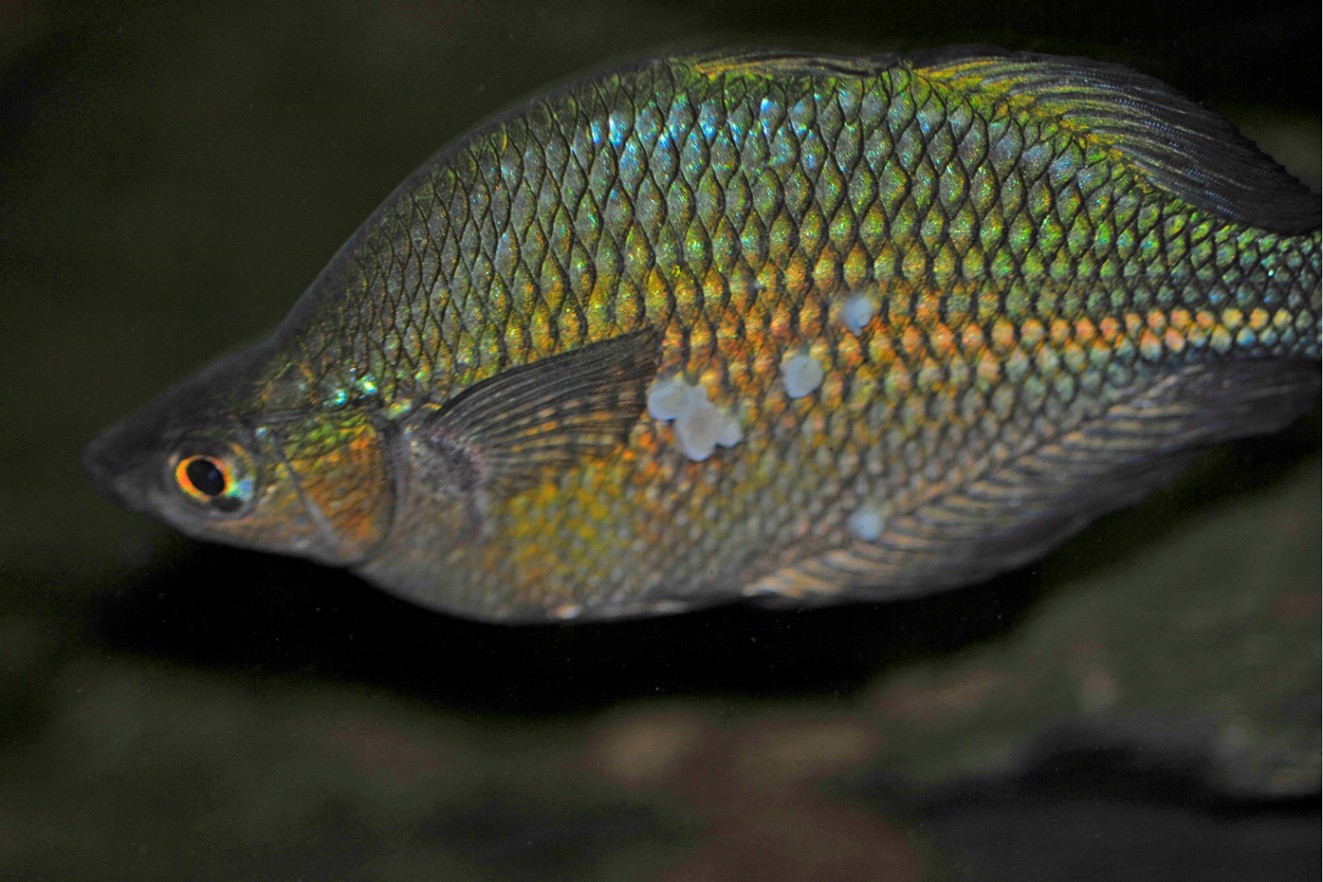
Toledo Zoo staff Jay Hemdal, Curator of Fishes and Invertebrates and Dr. Yousuf Jafarey, staff veterinarian answer your questions about fish health issues.
Question:
Some of the rainbowfish in my aquarium have raised greyish-white lumps on their bodies. I haven’t added any new fish for over a year and the water checks out fine. They’ve had these spots for over a month now, is the problem serious?
Answer:
 Your fish have an infestation of a peritrichous ciliate protozoan related to the genus Epistylis or possibly Vorticella. These one-celled organisms are actually not parasites; they filter the water for particles of food. They grow in colonies and use their stalked bases to attach to various surfaces. In the case of fish, Epistylis can only attach to areas where the fish’s skin has been damaged. In the image above, you can see that each colony of Epistylis is growing where a scale is missing. Continued presence of the colony irritates the skin so that it doesn’t heal properly. Although rarely fatal, this malady is unsightly. It only affects freshwater fish, and is sometimes found growing on the shells of turtles. Although these protozoans are easily eradicated, they usually return after treatment, so a long-term cure is difficult to achieve. Short-term relief can be gained by treating your aquarium with one of the standard Ick cures. For fish that can tolerate it, such as your rainbowfish, a long-term bath of 4 parts per thousand of synthetic sea salts will help. To dose sea salt at this rate, first determine the actual volume of your aquarium (length x width x height in inches, divide by 231 and then multiply by .90 to account for water displacement by gravel and tank decorations). Using this volume, multiply it by 15. This is the total grams of salt to add, but it must be added slowly, so split the amount of salt into thirds and add one third to the aquarium once a day for three days. If you do not have an easy way to measure grams of sea salt, you can figure that one level teaspoon of salt weighs about five grams. Leave the fish in this mild brackish water condition for at least six weeks. Don’t use aquarium salt or regular sodium chloride alone, as the calcium in the synthetic sea salts makes this treatment less toxic to freshwater fishes, while still being deadly to the protozoans.
Your fish have an infestation of a peritrichous ciliate protozoan related to the genus Epistylis or possibly Vorticella. These one-celled organisms are actually not parasites; they filter the water for particles of food. They grow in colonies and use their stalked bases to attach to various surfaces. In the case of fish, Epistylis can only attach to areas where the fish’s skin has been damaged. In the image above, you can see that each colony of Epistylis is growing where a scale is missing. Continued presence of the colony irritates the skin so that it doesn’t heal properly. Although rarely fatal, this malady is unsightly. It only affects freshwater fish, and is sometimes found growing on the shells of turtles. Although these protozoans are easily eradicated, they usually return after treatment, so a long-term cure is difficult to achieve. Short-term relief can be gained by treating your aquarium with one of the standard Ick cures. For fish that can tolerate it, such as your rainbowfish, a long-term bath of 4 parts per thousand of synthetic sea salts will help. To dose sea salt at this rate, first determine the actual volume of your aquarium (length x width x height in inches, divide by 231 and then multiply by .90 to account for water displacement by gravel and tank decorations). Using this volume, multiply it by 15. This is the total grams of salt to add, but it must be added slowly, so split the amount of salt into thirds and add one third to the aquarium once a day for three days. If you do not have an easy way to measure grams of sea salt, you can figure that one level teaspoon of salt weighs about five grams. Leave the fish in this mild brackish water condition for at least six weeks. Don’t use aquarium salt or regular sodium chloride alone, as the calcium in the synthetic sea salts makes this treatment less toxic to freshwater fishes, while still being deadly to the protozoans.
Ultimately, Epistylis has two basic needs; a place to grow (injured fish tissue) and food (particles of organic material in the water). Ensuring the fish don’t reinjure their skin reduces sites where Epistylis can grow. This may require separating fish that fight, such as cichlids the “lip lock” each other in fights over territory. Increased partial water changes and better mechanical filtration will both help to reduce the food sources Epistylis needs in order to thrive.
The old Toledo Zoo Aquarium, with its antiquated filter systems had high levels of organic particulates in its freshwater systems that made Epistylis something that had to be routinely treated for. The new Aquarium, opening in 2015 will utilize state-of-the-art life support systems that will certainly reduce the prevalence of this disease.
We welcome your fish health questions, and hope to provide timely information to allow you to become more successful with your aquariums. If we can help you maintain your aquariums better, and make them more sustainable, it helps us meet our primary mission of “Inspiring others to join us in caring for animals and conserving the natural world”. So ask away and we’ll try to help!



I have an 11 year old red belly piranha. Ever since I cleaned the tank it has been freaking out. The ph is normal and oxygen is fine. It’s been doing this for a week and I have no clue how to help her